|
Sir George Duckett (formerly Jackson), first baronet, naval administrator and judge, was born 24 October 1725, probably in Yorkshire. He was the third but oldest surviving son of George Jackson (1687/8–1758) of Hill House, Richmond, Yorkshire, and Hannah, daughter of William Ward of Guisborough, Yorkshire. George entered the Navy Office as clerk to the clerk of the acts in 1743. In 1755 he became chief clerk to the clerk of the acts and from 1758 to 1766 was assistant clerk of the acts. On the recommendation of prime minister William Pitt, he was then transferred to the admiralty as second secretary to the board and first clerk of the marine department. In 1768 he was made judge advocat of the fleet, a position he held until his death. He also served as a Member of Parliament for Weymouth and Melcombe Regis (1786–1788), and Colchester. He gained the Colchester seat with government support in 1788 and though unseated on petition, regained the seat at the 1790 election and held it until the 1796 election.
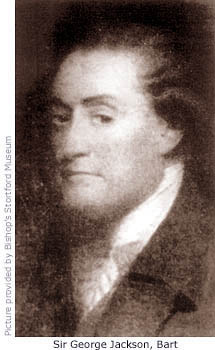 On 24 September 1745, in London, he married his cousin Mary Ward. She died in 1754 leaving three surviving daughters. On 9 September 1775 at St Margaret's, Westminster, he married his second wife Grace (d.1798), daughter and heir of London merchant Gwyn Goldstone of Goldstone, Shropshire, and his wife Grace Duckett. They had one son, George (1777–1856), who subsequently became an MP and banker. The failure of his bank in 1832 destroyed the Duckett fortunes (See Guide 11 – Stort Navigation). On 24 September 1745, in London, he married his cousin Mary Ward. She died in 1754 leaving three surviving daughters. On 9 September 1775 at St Margaret's, Westminster, he married his second wife Grace (d.1798), daughter and heir of London merchant Gwyn Goldstone of Goldstone, Shropshire, and his wife Grace Duckett. They had one son, George (1777–1856), who subsequently became an MP and banker. The failure of his bank in 1832 destroyed the Duckett fortunes (See Guide 11 – Stort Navigation).
In 1791 Jackson was created a baronet, and in 1797 inherited the Hartham estate of his second wife's second uncle, Thomas Duckett, at Corsham, Wiltshire. However, under the terms of the eccentric uncle's will, Sir George Jackson Bart had to assume the name and Arms of that family by royal licence in order to secure the inheritance. He became Sir George Duckett, Bart. Presumably he had lived on the Duckett estate for some years prior to Thomas Duckett's death, because when made a baronet he had been described as 'of Hartham House'.
In 1759, Thomas Adderley (landlord of the Crown Inn at Hockerill) succeeded in gaining an act of parliament to make the river Stort navigable. The plan failed through lack of finance but when Jackson heard of this he stepped in to help. He and two others sat as commissioners for a new Act in 1766 (See Stort Navigation), then saw to it that enough financiers were in place to make the project a reality. The Stort Navigation was completed in 1769. In 1797, thanks to the sizable inheritence left him by his wife's uncle, he bought out the other financiers of the Navigation to become principle shareholder. George Jackson was held in such high regard by all associated with the Navigation that many of the Lock Keepers' cottages proudly displayed a badge or door plaque bearing his initials. At least two of these are said to survive.
In Bishop's Stortford, both his surnames are remembered: first in Duckett's Wharf, a large housing and office development in (lower) South Street that is built partly on the original riverside wharf of the same name, and in the town's Jackson Square shopping centre. His name is also perpetuated on the other side of the world: Point Jackson in New Zealand and Port Jackson in New South Wales, Australia – better known as Sydney harbour. Both were named in his honour by his protégé, Captain James Cook, who set sail in the Endeavour in 1768 to chart the Southern Seas.
Cook's father was an agricultural labourer from Marton, North Yorkshire, and had been a dependant of the Jackson family. James became a stable-boy in George Jackson's sister's household at Ayton, Yorkshire. It was there that the influential Jackson gave the boy every encouragement to join the Royal Navy, which he did in 1743, and as we now know rose rapidly through the ranks to become one our most famous sea captains and explorers.
Sir George built and owned Wharf House in the Causeway but seldom stayed there, preferring instead his other homes in Roydon and London. Despite this, Bishop's Stortford meant a great deal to him and his greatest wish was to be buried in St Michael's churchyard. When he died at his London Home in Upper Grosvenor Street in 1822, aged 97, (he was said to be the oldest householder in London) that wish was fulfilled. His epitaph there simply reads: 'Sir George Duckett Bart, Died 15th December 1822, Aged 97'.
Such was the gratitude of the town for what both Sir George and Thomas Adderley did, each has a memorial dedicated to them inside St Michael's church. Some of the notes that Sir George (Jackson) Duckett kept, recording the events of the Navigation's construction, are now in the British Museum.
*Additional information taken from the Oxford Dictionary of National Biography
MORE PICTURES
|
|
Prior to town redevelopment in the early 1970s, Dane Street was the only direct road link between Station Road and Causeway – Riverside not constructed until 1973 and the former Adderley Road not being completed until August 1976.
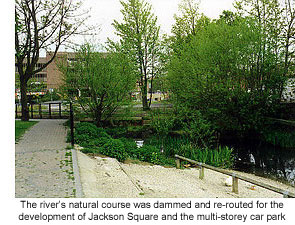 Parking a car in Bishop’s Stortford today can be loosely termed as a nightmare, but during the early 1970s the problem was much the same. At that time it was hoped the new multi-storey car park opened at Riverside in 1974 would ease matters, but it seems that a few extra signpost might have helped one hapless motorist who, it was reported, drove around the town for an hour and twenty minutes trying to find his way into it! Parking a car in Bishop’s Stortford today can be loosely termed as a nightmare, but during the early 1970s the problem was much the same. At that time it was hoped the new multi-storey car park opened at Riverside in 1974 would ease matters, but it seems that a few extra signpost might have helped one hapless motorist who, it was reported, drove around the town for an hour and twenty minutes trying to find his way into it!
From the early 1800s until the time of town redevelopment in the 1970s, the area of land between South Street and the river was made up of three thoroughfares: Patmore Yard, Carpenters Yard, and Anchor Yard – all mostly occupied by malt houses.
One notable exception was the cork factory, a business that moved to Anchor Yard from the East End of London in the early years of the Second World War. It was owned by a Mr T.D. Briggs from Portland Road who, prior to the move, had commuted daily for 42 years to the London factory originally started by his father. Fearing his premises would be destroyed by bombs in the Blitz (1940–41), Mr Briggs moved his business, as well as all his employees and their families, to the relative safety of Bishop’s Stortford. Cork was imported from Spain, and to improve production Mr Briggs installed a cork-cutting machine in his Portland Road home so that his family could help out.
In the 1920s he was privileged to be chosen as one of the many craftsmen engaged to supply miniature pieces for Queen Mary’s Dolls House – created by Edwin Lutyens – his task being to make the smallest cork ever made for a glass bottle. The dolls house, along with its miniature contents, is still displayed at Windsor Castle.
A common feature of many towns and cities during the Second World War was the British Restaurant. Initially these were communal kitchens that had been hurriedly set up during the Blitz to serve war workers and those who had been bombed out of their homes. They later opened up all over Britain to provide reasonably priced food for the needy and for evacuee children to ease the expense on their foster parents.
Stortford's British Restaurant was built around 1941/2 approximately where the rear of the former Sainsbury's store is sited in Riverside. After the war it was renamed the Civic Restaurant, catering not only for the needy but also serving school dinners to pupils from some local schools. It was also used as a Public Hall and for exhibitions and competitions but eventually closed in 1954.
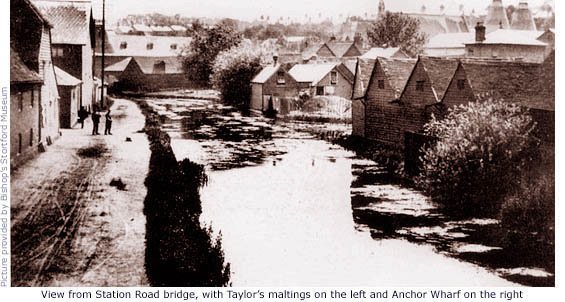
At the malting industry’s peak in the early 1800s, more than 40 malthouses were sited throughout the town, many of them built north and south of Station Road bridge for easy access to river. One such malting was set up by John Taylor (1763–1826), whose father Samuel Taylor had started the original business in Ware. The name H A & D Taylor has been associated with malting in Hertfordshire for well over 200 years.
A detached house owned by a local coal merchant once stood on the north-west side of the bridge, and on the south-west side were the work places of the bargees – St Catherine’s Wharf, Swan Wharf/Dock, Phipps Yard and Anchor Wharf. MORE PICTURES
|


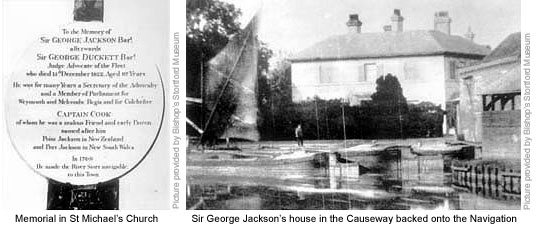

 On 24 September 1745, in London, he married his cousin Mary Ward. She died in 1754 leaving three surviving daughters. On 9 September 1775 at St Margaret's, Westminster, he married his second wife Grace (d.1798), daughter and heir of London merchant Gwyn Goldstone of Goldstone, Shropshire, and his wife Grace Duckett. They had one son, George (1777–1856), who subsequently became an MP and banker. The failure of his bank in 1832 destroyed the Duckett fortunes (See Guide 11 – Stort Navigation).
On 24 September 1745, in London, he married his cousin Mary Ward. She died in 1754 leaving three surviving daughters. On 9 September 1775 at St Margaret's, Westminster, he married his second wife Grace (d.1798), daughter and heir of London merchant Gwyn Goldstone of Goldstone, Shropshire, and his wife Grace Duckett. They had one son, George (1777–1856), who subsequently became an MP and banker. The failure of his bank in 1832 destroyed the Duckett fortunes (See Guide 11 – Stort Navigation). Parking a car in Bishop’s Stortford today can be loosely termed as a nightmare, but during the early 1970s the problem was much the same. At that time it was hoped the new multi-storey car park opened at Riverside in 1974 would ease matters, but it seems that a few extra signpost might have helped one hapless motorist who, it was reported, drove around the town for an hour and twenty minutes trying to find his way into it!
Parking a car in Bishop’s Stortford today can be loosely termed as a nightmare, but during the early 1970s the problem was much the same. At that time it was hoped the new multi-storey car park opened at Riverside in 1974 would ease matters, but it seems that a few extra signpost might have helped one hapless motorist who, it was reported, drove around the town for an hour and twenty minutes trying to find his way into it!
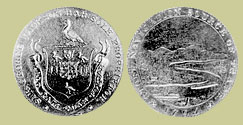 A national shortage of small denomination coinage in the late 18th century forced many companies to issue their own tokens. Among them was George Jackson, who in 1795 issued the Stortford Halfpenny token for use on the Stort Navigation and made it redeemable for conventional money at the company's offices at Swan Dock. It's not known how many of the tokens were originally produced at the Soho Mint in Birmingham, but a small number are still in existence.
A national shortage of small denomination coinage in the late 18th century forced many companies to issue their own tokens. Among them was George Jackson, who in 1795 issued the Stortford Halfpenny token for use on the Stort Navigation and made it redeemable for conventional money at the company's offices at Swan Dock. It's not known how many of the tokens were originally produced at the Soho Mint in Birmingham, but a small number are still in existence.